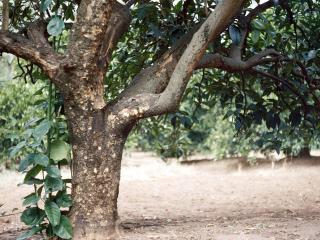Maintenance of vines and fruit trees
Fruit trees and vines need regular water and fertiliser to grow and fruit well. Unmanaged trees and vines are much more likely to harbour pests and diseases.
Maintenance includes pest and disease control, pruning and tree training, thinning of excess fruit and the removal of pruned limbs and fallen fruit. These practices are essential to control pests and diseases such as peach leaf curl, apricot freckle, brown rot, powdery mildew, scale insects and mites within the orchard.
Monitor your fruit trees for pests and diseases and undertake preventative and/or control strategies as required.
Copper sprays help control most fungal and bacterial diseases including leaf curl, shot-hole, freckle, black spot, bacterial canker, brown rot and sooty mould. Apply them to all fruit trees and vines, including evergreens, where the fungicide will control sooty mould and brown rot.
Apply the first copper spray for deciduous trees at the first sign of leaf fall. If the spray burns the leaves it will force the trees into dormancy which is beneficial in our warm climate as you can gain some extra chilling hours.
In south-west Western Australia spray at the start of May in cool areas through to the end of May in warmer areas.
Apply a second spray on deciduous trees at the first sign of bud swell before the leaves emerge. Once the leaves form only synthetic fungicides should be used to prevent leaf burn.
For powdery mildew in grapevines apply a lime sulphur spray during dormancy and wettable sulphur after budburst.
Many fruit types require a combination of baits, splash baits, traps, cover sprays and/or fruit fly netting to effectively control Mediterranean fruit fly infestations. If you cannot meet these requirements and produce a crop which is not infested with fruit fly you sould sesriously consider removing the trees.
Gardeners who enjoy the beauty of trees and are unwilling to undertake baiting and netting can strip all immature fruit to prevent fruit fly breeding. Fruit should be harvested from productive trees and windfalls collected and placed in a sealed plastic bag before disposal.
Fruit stung by fruit fly can also be collected and stored in a bucket of water with a layer of vegetable oil on the surface. Regularly inspect your trees; early detection will reduce the cost of controlling pests and diseases.
An unmanaged / neglected vineyard is a breeding ground for Mediterranean fruit fly and downy mildew. If a vineyard cannot be managed appropriately, pull it out.
To ‘mothball’ a small number of backyard grapevines, regularly remove all foliage. The vines will re-sprout.
Removing unwanted fruit trees
Removing the roots of an unwanted tree or vine will avoid suckering. If that can’t be done, trees can be killed by applying a registered herbicide such as 'blackberry and tree killer', to the stump. It is critical that the herbicide is applied to the stump immediately following the cut. If that cannot be done for practical reasons, notch the live trees near ground level with an axe and apply a registered herbicide immediately into the notch.
Thorough checking of the area needs to be carried out for at least two years following the removal operation to monitor possible regrowth. Regrowth can be controlled by spraying with a herbicide like glyphosate.

